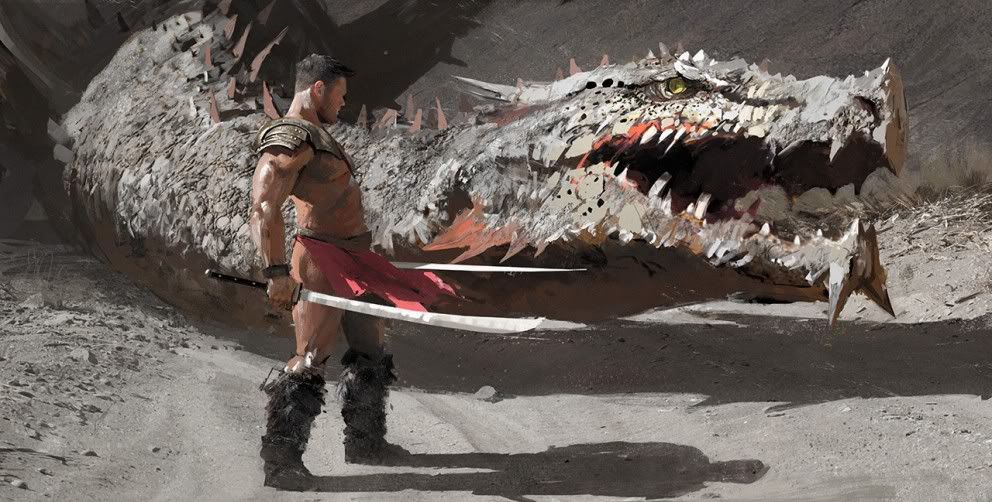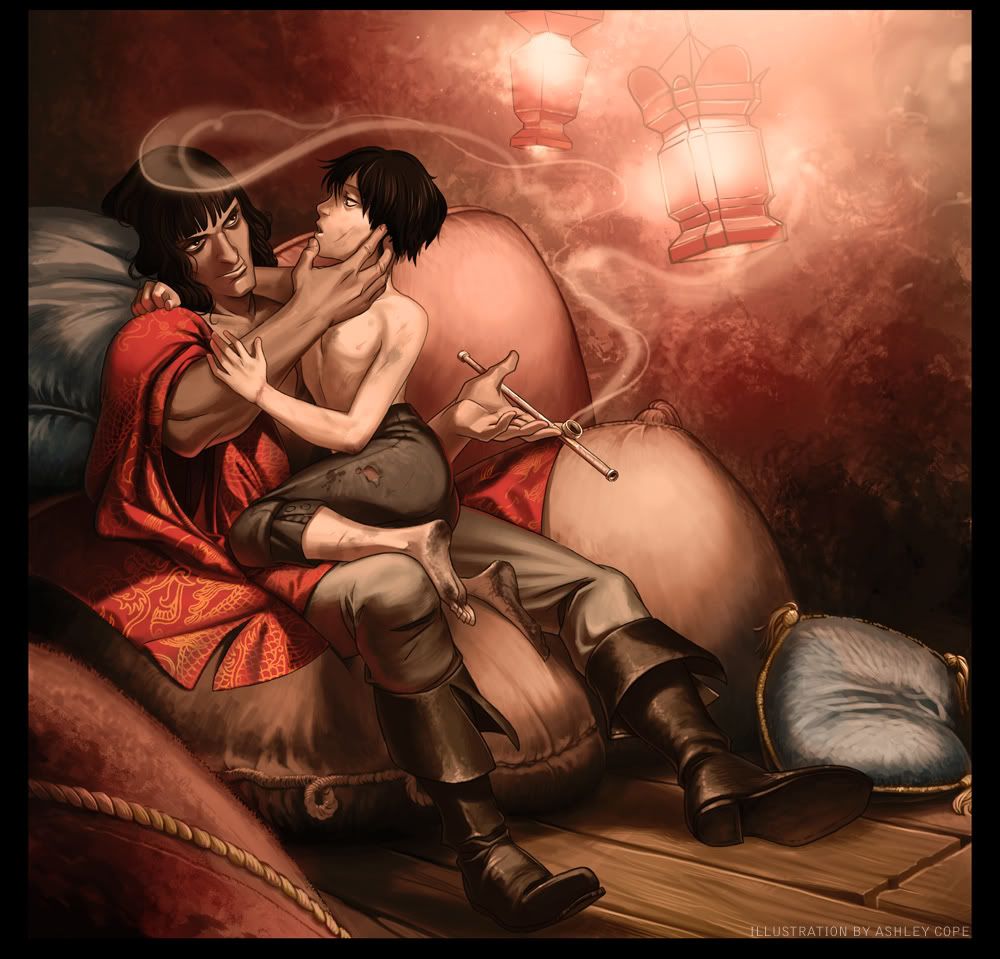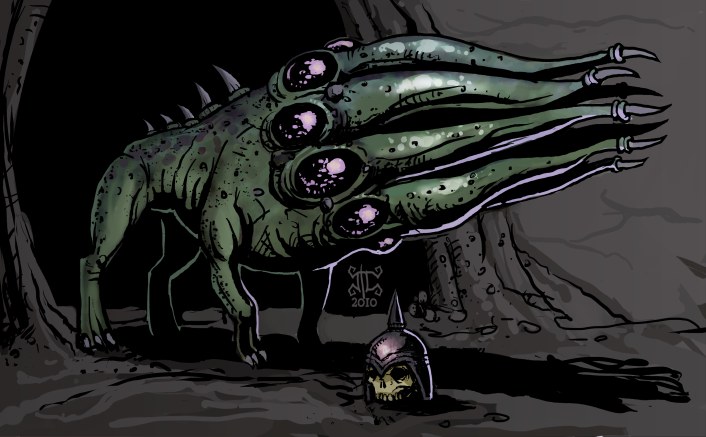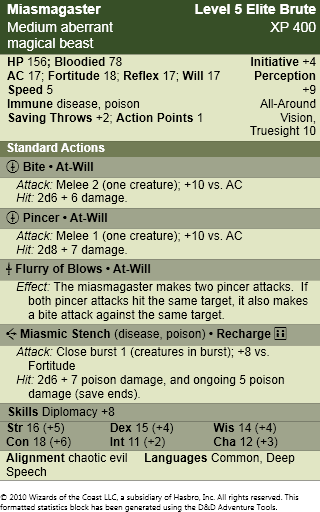 |
| The watchword of this session. |
When last we left our heroes, they helped the rabbis retrieve a book, fought some prairie ticks, killed a Dustman, acquired the Box of Kakisis, returned to David Hood's house, were awakened in the night by the humanoid bat creature that may or may not be the Angel of Death, and chased it off.
Also, said creature is Ruby's mutated brother.
Cue hilarity.
One can hear the baying of hounds. Like,
all the hounds in Boston. There's some talking. David, Jake, and Jeb repair the broken barricade on the window; while doing so David peeks outside to note that a huge pack of dogs is going up the street. Their eyes glow unnaturally, and they sniff each door before pressing forward. Father Seward
lays on hands and heals Rufina's wounds. The sound of glass breaking is heard down the street. Screams follow.
Content that the dogs bypassed the house, Father Seward sticks his head out the door to see a veritable army of dogs outside a house about six doors down. They are forcing their way into the house through the window.
Astute observers also recall the next symbol on the Doomsday Clock face — a jackal's head. The second hour (or day, if you prefer) has passed on the clock. Eleven to go.
Since there isn't much to be done against an army of several dozen dogs, the group closes the door. David Hood has
the seemingly insignificant but ultimately brilliant idea of investigating the bowl that the John-Michael-Patrick-bat-thing brought. Between he and Father Seward, they determine it to be a heavy-ish metal, perhaps pewter — odd, considering that the maker's mark suggests it was made by
Paul Revere. However, it seems likely that the lack of silver in the composition means that it was either a special commission, or that no silver was available — Seward posits that perhaps it was made during
the War, and supply lines were scarce.
With the excitement complete, everyone returns to sleep.
Morning comes and everyone awakens. David wanders upstairs and looks out a window — there isn't much activity on the street, although he notes something at the house that was attacked by dogs in the night. A couple stands on the roof. They are well-dressed, standing at the edge of the roof. The woman has a sling around her neck; it obviously contains something and the bottom is stained crimson. The pair raises pistols to their temples and pulls the triggers, their lifeless bodies falling into the streets below.
At the sound of gunshots, everyone is on alert, but David explains what he just saw.
It's another day, and another time for a foray into the city. Food needs to be acquired. Father Seward needs some more .44 bullets (although Ruby has some). David needs about $20 more dollars to hit $500 so he can pay his boat captain. After some discussion, David, Jeb, and Rufina will go out. Father Seward, Jake, and Ruby will stay to guard the rabbis.
David, Jeb, and Rufina go to the house six doors down to look at the bodies and see what can be scrounged. Upon examination, it is clear the couple is relatively well-to-do, although not super-rich, and they are wearing their Sunday best. The woman wears diamond earrings and other assorted jewelery; Rufina leaves the wedding band, but takes the other jewelery and the two pistols (later determined to be Colt Army pistols, each with five shots remaining). Upon turning the woman over, it is clear what she is carrying in the white sling — the largely clean bones of a child, one ripped to shreds by animals. The dogs must have gone from house-to-house killing newborns.
The trio then goes through the rest of the house, finding $17 (quite fortunately, this brings David Hood's total to $500.25), three more .44 rounds, and assorted jewelery that is largely ignored.
David, Jeb, and Rufina then go into town, raiding what food they can before heading to the docks.
On the way, they pass the cathedral. A crowd is gathered out front, and a man in a top hat appears to be addressing them. David and Jeb somehow see through the shroud to determine that he is
Bashiel, the demon responsible for slaying the religious leaders in Boston. They inform Rufina that
that's the guy, and everybody hears what he's saying — he claims the city's Jewish leaders performed this atrocity, and that they should be purged. David and Jeb decide to continue to the docks, while Rufina will hustle back to Hood's house to warn the others.
David and Jeb make it to the docks without incident, and David finds the boat captain. He pays him the $500 and the man takes the riverboat out into the harbor; upon positioning it, the captain realizes this is the
Peerless and says it is a cursed boat owned by a cursed family. David and Jeb crawl onto the overturned hulk of the
Peerless before the captain notes that it will sink if they cut through the hull.
David decides to return to his house while Jeb stays behind to make sure the captain doesn't run off with his $500.
Meanwhile, Rufina returns to Hood's townhouse to inform everyone of Bashiel's gathering anti-Semitic army. She also delivers some food — the rabbis appreciate, although they do note that they're not as appreciative of the ham (
Rufina didn't know) — then leaves to get a good vantage point. She picks the abandoned house six doors down and sits on the roof and sees some movement and isolated fires, but no roving gangs just yet.
While she's away, Father Seward continues his reading, but seriously considers blessing his guns and going after Bashiel. Jake and Ruby go off alone to discuss things — largely about an attempted kiss the previous day, and where their relationship is headed.
David Hood returns and informs everyone of the situation, being sure to mention that they probably shouldn't mention his surname in the captain's presence. The rabbis pull Father Seward aside and inform him that there's a chance of stopping the clock, but it appears to require a holy man, and since he's one of the few remaining, he should stay safe. There's some bickering as Father Seward thinks they should be focusing more on stopping the clock than moving the clock, but the group decides to head in the direction of moving the clock (it'll need to be accessible to stop it, right?) and finally determines that the best way to handle the problem is by using leather bladders to keep the ship afloat.
Still early in the day, it is decided: David, Jake, and Rufina will return to the shipyard to meet with Jeb and start filling bladders. Father Seward and Ruby will stay behind to aid the rabbis. Rufina leaves one of the Colt Army pistols with Father Seward and he makes certain it is fully-loaded.
It's about 3:30 when Rabbi Ezekiel says there is a ritual. It is mostly translated, and they expect to complete the translation sometime that night. Rabbi Ezekiel says that the ritual does require some components that are absolutely necessary — a holy man (it sounds like this person has to be an actual clergy member, although the religion isn't important), holy water (although the holy water can be any water prepared by a person of faith, not necessarily full-on holy water), and a silver bowl.
Father Seward thanks them for the information, and he and Ruby discuss what to do. She wonders if her brother/bat-thing was trying to perform the ritual; Seward says the thought occurred to him. After some discussion, they decide to go get a silver bowl. Father Seward asks if the rabbis will be all right, and leaves the loaded Colt Army with them.
Father Seward and Ruby go a few blocks over and find a silversmith that is still open. They enter and Father Seward asks for a silver bowl of rather large circumference. The proprietor of the shop asks if it should be the size of a baptismal, and Father Seward says that will be fine. The proprietor asks when Ruby is due, and Father Seward says it's nothing like that — although he does shoot her a quick, quizzical glance knowing that she's spent some recent time alone with Jake. He does confirm the proprietor's suspicion that the children have been killed.
The shopkeeper brings a silver bowl with cherubs on it, and Seward says this is acceptable. When he explains that he can't pay for it, but his friend has very good credit, the shopkeep says he'll trust him if he'll bless four silver crosses and promise to pay for it when he is able. Father Seward agrees and a deal is struck. He throws a cloth over the bowl and he and Ruby start to return to Hood's house.
They arrive just in time to see Bashiel and the mob exiting the house. Bashiel throws a lantern into a second story window and the mob leaves. Both come to the entrance, and Seward tells Ruby to stay there with the bowl. He goes inside, pulls out a burning rug so the house doesn't catch fire, and then makes the trek into the kitchen.
All five rabbis are dead. Four have been badly beaten and stabbed; one has been relatively untouched, but has been impaled against the wall by a lamppost. All six shots have been discharged from the Colt Army. Father Seward makes a quick examination and determines the following:
- The Box of Kakisis is still in the closet, and is closed. It appears totally unmolested.
- Of the Fall of Man and the book of translations, there is no sign.
- The impaled rabbi died roughly an hour before everyone else, and apart from the impalement, has barely a scratch.
- A box sits in a corner of the room. Atop it sits a note in Hebrew.
- The box itself contains a human tongue.
Content that everything is relatively safe, Father Seward invites Ruby into the house but tells her to avoid the kitchen. They make sure they have everything. Father Seward takes the note in Hebrew and blesses two of his bullets; they are considered blessed against Bashiel only until sundown.
Father Seward and Ruby make it down to the docks by 7:30 PM. Father Seward informs everyone that the rabbis are dead and that Bashiel took the notes. He suggests he's going to confront Bashiel and the mob and then turns and leaves. Jake follows. Ruby follows Jake; when Father Seward notes that they're following him, he tells Ruby to stay behind because she has no hope of injuring Bashiel. Jake might be able to do so.
As Father Seward and Jake walk away, both David Hood and Jake notice a man on a nearby rooftop, staring down at them while shuffling cards. Jake doesn't recognize the man, wearing top hat and tails, but David certainly does.
It is the ghostly Gentleman, the one previously only manifesting to David Hood and Father Seward.









































